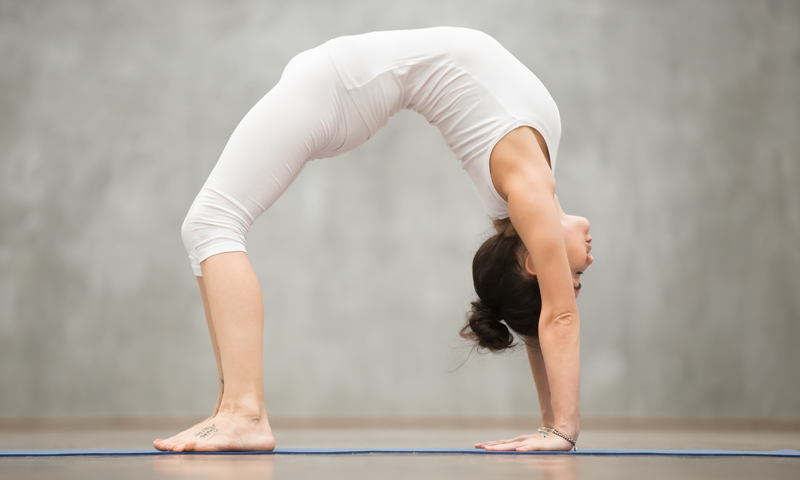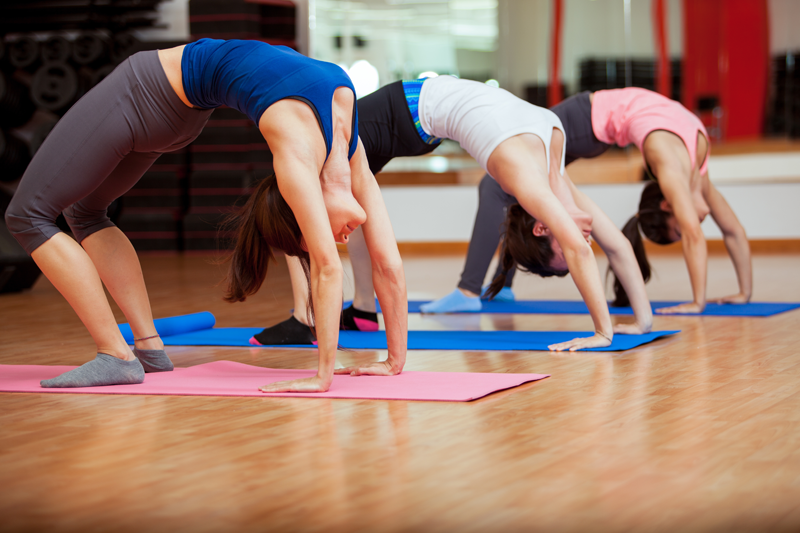
5 Signs You Have a Yoga Teacher Who Empowers You
January 9, 2020
7 Ways You Could be Sabotaging Your Yoga Practice
January 23, 2020The Wheel Pose: A Yoga Pose for Life

Wheel Pose, otherwise known as Urdhva Dhanurasana or Upward Facing Bow, is an intermediate backbend that offers a host of benefits to the mind, body and spirit. Best practised in a flexible pair of yoga pants, the asana requires a moderate skill level. So, what is so great about Wheel Pose? and how do you practice it? In this article, we explore the Wheel Pose: a yoga pose for life.
What is Wheel Pose?
Wheel Pose is an intermediate, heart-opening yoga pose that strengthens and stretches the whole body. In Sanskrit, the posture is known as “Urdva Dhanurasana”, which translates to Upward Bow Pose. However, many practitioners refer to it as Wheel Pose.
The asana is a deep backbend, so requires a good amount of flexibility to practice effectively. For best results, remember to warm up the body before attempting it. Most practitioners practice Wheel Pose towards the end of their routine, to give the muscles time to open up. Before attempting Wheel Pose, practice some heat-building standing poses or a full-body sequence. Move onto a few beginner backbends, such as Bridge Pose or Puppy Pose, to prepare the spine.
Why is Wheel Pose Important?
So, now we know what Wheel Pose is, but why is it so important? We spend the majority of our time standing upright or slouching forwards. Sitting at a desk, on a sofa or in a car usually involves spinal flexion. In day to day life, we rarely need to bend over backwards.
Unfortunately, we become used to sitting in a hunched position with a rounded spine, dropped shoulders and our head hung forward. Over time, this can cause numerous issues including back pain, poor posture, bad digestion and restricted breathing.
To keep the spine happy and healthy, make a conscious effort stretch it in the opposite direction frequently. You can do this through simple stretches while sitting at your desk or commit to a regular yoga class that involves more intense backbends. Wheel Pose is ideal for building strength and flexibility in the spine and counteracting the effects of slouching.
How to Practice Wheel Pose
To practice Wheel Pose, begin laying on the mat with your knees bent. Keeping your feet hip-width apart, press your feet into the ground to lift your bottom and back off the mat. Press your hands into the ground and open your chest. Finally, lift your stomach towards the ceiling and tilt your head back. You are in Wheel Pose.
It is recommended to hold the asana for one to three minutes, depending on your skill level. With regular practice, you should be able to gradually increase the hold time. If you’re unable to practice Wheel Pose just yet, don’t panic! If you’re new to yoga, intense backbends can be tricky. Start with an earlier stage of the posture like Bridge Pose and build up your strength and flexibility. While advanced asanas can have amazing health benefits, they can also have contradictions. If you suffer from carpal tunnel syndrome, headaches, heart irregularities, back pain or high or low blood pressure, you should perform Wheel Pose with extreme caution. If you have any doubts, it may be best to consult your health practitioner before practising the asana.
Benefits of Wheel Pose

Strengthens and Lengthens the Vertebrae
When practised regularly, the asana can lengthen and strengthen the vertebrae, increasing flexibility and elasticity of the spine. As we age, the spine compresses. However, asanas like Wheel Pose create the necessary space to keep the spine happy, healthy and standing tall.
Strengthens the Muscles
Wheel Pose strengthens muscles all over the body, including the arms, abdomen, wrists, legs, chest and shoulders.
Enhances the Nervous System
When practised regularly, Wheel Pose enhances the nervous system and improves hormone secretions. This helps to keep the body in optimal health. Studies have shown that the hormonal balance induced by Wheel Pose can aid fertility.
Opens the Chest
Wheel Pose opens the chest and strengthens the lungs. This allows more oxygen into the rib cage for improved respiration. Studies have shown that the asana can be beneficial for those who suffer from asthma. For best results, remember to breathe deeply while holding the pose to open the chest fully.
Energises the Body and Mind
Wheel Pose energises you, both physically and mentally. Studies show that the pose counteracts depression, stress and anxiety. This is because the pose stimulates the thyroid and pituitary glands when held for an extended period.
Removes Fat
As you lean back into Wheel Pose, you remove fat build up from your obliques. When used regularly, the asana can have a slimming effect on the body.
Ignites the Chakras
Wheel Pose is believed to ignite all of the chakras. This keeps the body, mind and spirit working in harmony with one another.
Opens the Heart
The asana is a heart-opening backbend. Some yogis believe that heart openers cure broken hearts while welcoming the opportunity for new love. Intense backbends like Wheel Pose require a level of vulnerability, but it won’t be long before your heart is open and ready for new love.
Challenges of Wheel Pose
Like all advanced yoga poses, Wheel Pose comes with a set of challenges. The biggest challenge is getting all the way into the pose. There are various reasons why you may struggle with this, such as having tight hips or shoulders, tight quads, or having a weak back or weak arms and wrists. Thankfully, all of these issues can be resolved through regular yoga practice. Don’t rush your body into an asana that it’s not ready for. Instead, give yourself time to increase your strength and flexibility, building up to Wheel Pose with easier backbends. Over time, you’ll develop the skills needed to practice Wheel Pose effectively.
In Summary
So, there you have it – the Wheel Pose: a yoga pose for life. For best results, throw on your favourite yoga top and practice daily. If you cannot move all the way into Wheel Pose, don’t panic! With time and practice, you’ll get there in the end.

